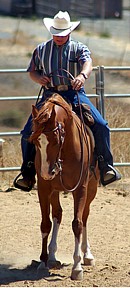|
Art Gallery (Horse Art) |
|
|
|
|
|
||
|
Recently I started a 4 year old filly that was well prepared by her owner and ready to ride. Like most trainers, I have a checklist I go through before stepping on a horse for the first time. After determining she was ready to ride, I began her training. Her first two rides were short. By then I felt she was ready for her first long ride on what I call the Chair Loop. The loop, a 3.3 mile trail with diverse terrain, is one of my favorite training rides. It has a single lane dirt road, a single track trail, large open areas, uphill and downhill opportunities, walkover and walk under obstacles, some slippery places during winter and, of course, many water obstacles in a variety of sizes. Usually it takes 1 1/4 to 1 1/2 hours depending upon how much stopping, backing and circling needs to be done. Since this was her first time, it took closer to 2 hours. One particular place on the loop has a large chunk of wood about 3 cubic feet in size. It lies on a turn in an open area on the left side of the trail, when riding in a counter clockwise direction. As we approached it, the filly stopped, raised her head and was ready to turn and flee just as her ancestors had done for thousands of years. My objective: to manage the natural instinct to flee---the fright and flight behavior. Flight is the horse’s first response to fear and can be hazardous to the rider, if not anticipated. When I encounter such obstacles, the most advantageous riding position is to keep my center of balance on the horse’s centerline, no lateral lean of any degree from my upper body; the only lean is forward or slightly to the rear. The horse is only allowed to face the object, and to back as far as needed in order to feel safe. When using this No Spook technique on any trail, the rider must use good instant decision making skills to evaluate the trail’s safety. If I am not able to use the technique because of unsafe trail conditions, I may retreat, work around the obstacle or dismount and lead around a difficult object, but I will continue passing it daily until he decides it is safe. Assuming the trail is safe, with plenty of backing room, I keep the horse straight allowing him to back until he stops. Now, I wait……he can hold that distance as long as needed. I just wait. Soon the horse begins to raise and lower his head and I can feel him relax. When he works his lips, I squeeze with my legs to encourage one or two forward steps. The role of the rider is important; therefore, it is essential for him to be the leader and to ask for the stop. I repeat the process a few times, then I ask him to back away releasing the pressure of the object. I wait about 10-15 seconds, squeeze with my legs again to move forward and repeat until I can feel him relax. By this time curiosity usually begins to get the best of him and he can be sent straight to the object. I like to let the horse smell it, but he may not, nor even look at it because he has decided it is safe. As a reward, sometimes I will rub him on the hip; but do not forget, the release also tells him he gave the correct answer. I first used this technique on the fillies 3rd ride and it took 15-20 minutes. I never kicked, jerked or forced her towards the object. When she moved forward, it was her idea. Since then, we have passed the chunk of wood several times from either direction and she has not given it the slightest look. The episode was extremely valuable because it gave her self-confidence, trust in me and the knowledge that I only ask her for what is safe and what she is capable of doing. By the 17th training ride, the filly had progressed to the point that I felt it was time to invite her owner to accompany us. This was my opportunity to coach the owner about her filly. Included in the ride was a narrow path about 8’ long with brush on the left and a hole about 8’ wide, 6’ long and 4’ deep on the right. When the filly saw it, she stopped. I sat still ready to keep her straight but it was not necessary. She studied it 10-15 seconds and, before I could squeeze her, she walked past it without a flinch. Further along the trail I asked her for a rated trot and canter through small and large mud puddles which she perfectly executed. Her ability to negotiate these obstacles without avoidance demonstrated her self-confidence growth. In my opinion I would rate this as a 5 star ride for the filly. She stood quietly on a slack rein at the midpoint of the ride while the owner, who was riding the fillies mother, and I talked about the concepts and techniques I use when preparing a horse. The filly never made a mistake, never stepped forward while we talked, never flinched or allowed her attention to wonder. True, there will be times in the future when her attention may wonder; this is common behavior for young ones. But, we now know what she is capable of doing this early in her riding career, so all we must do is nurture the good things and eliminate those we do not want. The secret to the No Spook technique is to allow the horse to decide it is his idea to proceed. Riding a horse is so simple that it is difficult. Less Is More---or---the less I do, the more the horse will give. It Works!!!!
Contact: email - slowway@hughes.net Keep Ridin’, Eric |

